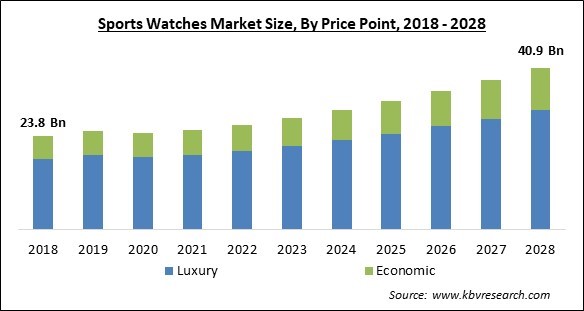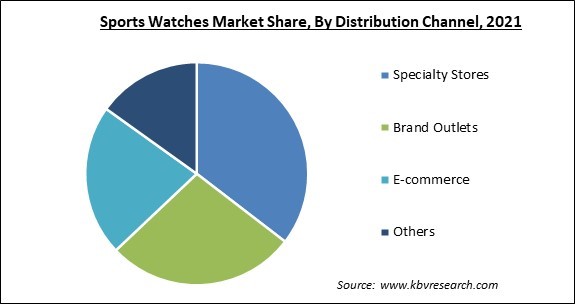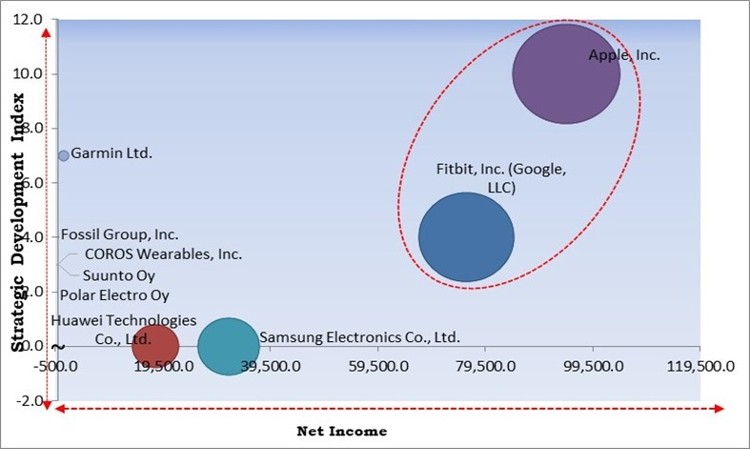The Global Sports Watches Market size is expected to reach $40.9 billion by 2028, rising at a market growth of 7.5% CAGR during the forecast period.
A sports watch is characterized as being extremely practical, robust, and frequently water-resistant. A sports watch needs to be easily readable, relatively shockproof, and extremely resistant to physical contact and scratches. A stopwatch and a timer for jogging or other physical exercise are typically included in this. Though some wristwatches called chronographs also include a stopwatch function, it is more frequently found in digital sports watches like G-Shocks.

Diver's watches, for example, frequently have an outer revolving bezel that doubles as a timer and is quite practical. Divers frequently utilize dive bezels to determine when their oxygen tank will run out. A watch is a portable, wearing clock that is portable. It is designed to keep moving continuously despite any motions caused by the person's activities.
A watch strap or other bracelets, such as one made from metal, leather, or another material, can be used to secure a timepiece around the wrist. In addition to typically being attached to anything, a pocket watch is designed to fit in a person's pocket. In the 17th century, watches were developed from spring-powered clocks, which originally appeared in the 14th century.
For the bulk of its history, the watch was a mechanical instrument that ran on clockwork, was powered by spinning a mainspring, and kept time by oscillating a balancing wheel. These watches are referred to as mechanical. The electronic quartz watch, which used a vibrating quartz crystal to keep time and was powered by a battery, was created in the 1960s.
With the help of sports watches pre-symptomatic carriers are unlikely to be recognized using current testing techniques because most infections are only discovered after symptoms manifest, which makes it challenging to implement early-stage medications that reduce transmission. Therefore, there is a critical need for straightforward, reasonably priced methods for the early, real-time identification of COVID-19 can increase the growth of the sports watches market.
Sports watches that go above and beyond the standard fare can offer the user smooth biofeedback, which is information essential to athletic growth. When combined with data on the weather and oxygen levels, instantaneous data on speed, heart rate, and heart rate variability effectively paints a complete picture of the current training state. A seamless connection between information and real-time performance states is made possible by the biofeedback data a watch provides, something a phone can't claim.
Some sports watches have pre-installed features that can send users notifications to take a breather. Some of these applications offer the ability to customize someone's watch's daily reminders to take a moment to breathe, as well as guided breathing exercises that may last anywhere from one to five minutes and are intended to help people de-stress. Little prompts during the day to keep breathing in the back of the head can assist to lower overall stress levels, regardless of whether people are aware of the propensity to flip out under stressful situations or normally remain composed.
The heart rate sensor and steps counter in a smartwatch are not known for their accuracy. Hopefully, the brands are evaluating the data and trying to improve sensor feedback. Luxury goods cost a lot of money. That idea is neither novel nor ground-breaking. However, buying a Ferrari or an Andy Warhol painting results in a price tag that most people are happy to accept — seller, buyer, and the overall market — equivalent objects from the world of timepieces are frequently held up as "too expensive." Not that buying a watch for the same price as a sports car is a good idea.
Based on the Product Type, the Sports Watches Market is segmented into Mechanical Sports Watch and Digital Sports Watch. The digital segment witnessed a significant revenue share in the sports watches market in 2021. Digital watches have a more contemporary appearance and show the time digitally. Digital wristwatches either have LED or LCD dials. Quartz movement is used in digital timepieces, just like it is in analog watches.

On the basis of End Users, the Sports Watches Market is divided into Men and Women. The men's segment procured the largest revenue share in the sports watches market in 2021. There are several uses for sports watches. People frequently use them when exercising or engaging in sports, but many of them may be worn in a variety of situations without worrying about the watch being damaged because of their robust construction and water resistance.
By Price Point, the Sports Watches Market is classified into Luxury and Economic. The luxury segment garnered the highest revenue share in the sports watches market in 2021. It is because a luxury sports watch is more streamlined and durable than a dress watch while also being more attractive than a tool watch. The Audemars Piguet Royal Oak is the undisputed luxury sports watch that springs to mind when considering these, admittedly, rudimentary criteria.
On the basis of Distribution Channel, the Sports Watches Market is bifurcated into Brand Outlets, E-commerce, Others, and Specialty Stores. The e-commerce segment witnessed a substantial revenue share in the sports watches market in 2021. E-commerce is a result of the high internet penetration rate and rising smartphone usage. Consumer selections for home electronics purchases have been significantly influenced by online shopping sites like Flipkart, Walmart, and Amazon.
| Report Attribute | Details |
|---|---|
| Market size value in 2021 | USD 25.2 Billion |
| Market size forecast in 2028 | USD 40.9 Billion |
| Base Year | 2021 |
| Historical Period | 2018 to 2020 |
| Forecast Period | 2022 to 2028 |
| Revenue Growth Rate | CAGR of 7.5% from 2022 to 2028 |
| Number of Pages | 233 |
| Number of Tables | 423 |
| Report coverage | Market Trends, Revenue Estimation and Forecast, Segmentation Analysis, Regional and Country Breakdown, Competitive Landscape, Companies Strategic Developments, Company Profiling |
| Segments covered | Price Point, Distribution Channel, End User, Product Type, Region |
| Country scope | US, Canada, Mexico, Germany, UK, France, Russia, Spain, Italy, China, Japan, India, South Korea, Singapore, Malaysia, Brazil, Argentina, UAE, Saudi Arabia, South Africa, Nigeria |
| Growth Drivers |
|
| Restraints |
|
Region-wise, the Sports Watches market is analyzed across North America, Europe, Asia Pacific, and LAMEA. The Asia Pacific region procured a promising revenue share in the sports watches market in 2021. Due to the expanding consumer electronics sector and the quick emergence of smartwatch market vendors in the region's rising nations, Asia-Pacific is predicted to have the fastest growth in the smartwatch market.
Free Valuable Insights: Global Sports Watches Market size to reach USD 40.9 Billion by 2028

The major strategies followed by the market participants are Product Launches. Based on the Analysis presented in the Cardinal matrix; Apple, Inc. and Fitbit, Inc. are the forerunners in the Sports Watches Market. Companies such as Garmin Ltd., Samsung Electronics Co., Ltd., Fossil Group, Inc. are some of the key innovators in Sports Watches Market.
The market research report covers the analysis of key stake holders of the market. Key companies profiled in the report include Apple, Inc., Samsung Electronics Co., Ltd. (Samsung Group), Google LLC (Fitbit, Inc.), Huawei Technologies Co., Ltd. (Huawei Investment & Holding Co., Ltd.), Garmin Ltd., Fossil Group, Inc., COROS Wearables, Inc., Polar Electro Oy, Suunto Oy (Amer Sports Corporation), and Rolex SA.
By Price Point
By Distribution Channel
By End User
By Product Type
By Geography
The global Sports Watches Market size is expected to reach $40.9 billion by 2028.
Watches For Sports Offer Unparalleled Biofeedback are driving the market in coming years, however, Cost-Prohibitive And Inaccurate Data restraints the growth of the market.
Apple, Inc., Samsung Electronics Co., Ltd. (Samsung Group), Google LLC (Fitbit, Inc.), Huawei Technologies Co., Ltd. (Huawei Investment & Holding Co., Ltd.), Garmin Ltd., Fossil Group, Inc., COROS Wearables, Inc., Polar Electro Oy, Suunto Oy (Amer Sports Corporation), and Rolex SA.
The expected CAGR of the Sports Watches Market is 7.5% from 2022 to 2028.
The Specialty Stores segment acquired maximum revenue share in the Global Sports Watches Market by Distribution Channel in 2021 thereby, achieving a market value of $13.8 billion by 2028.
The Europe market dominated the Global Sports Watches Market by Region in 2021, and would continue to be a dominant market till 2028; thereby, achieving a market value of $15.4 billion by 2028.
Our team of dedicated experts can provide you with attractive expansion opportunities for your business.

